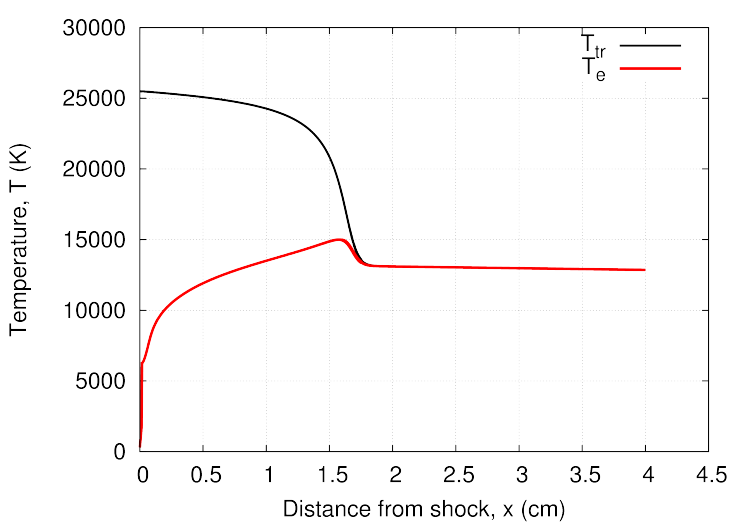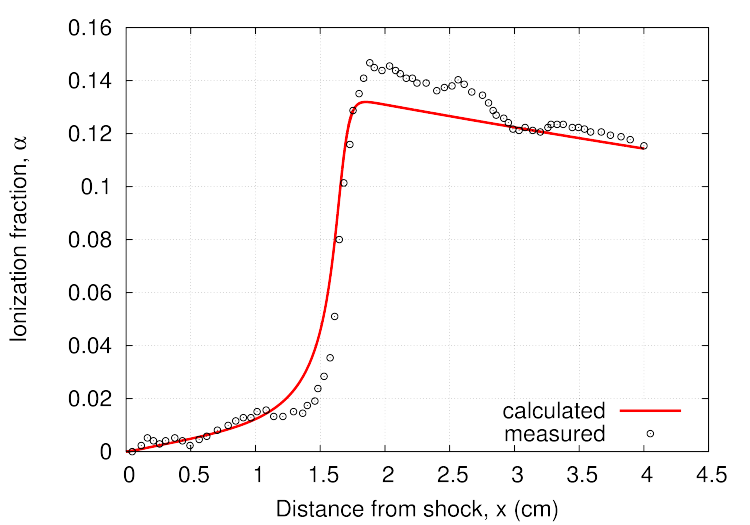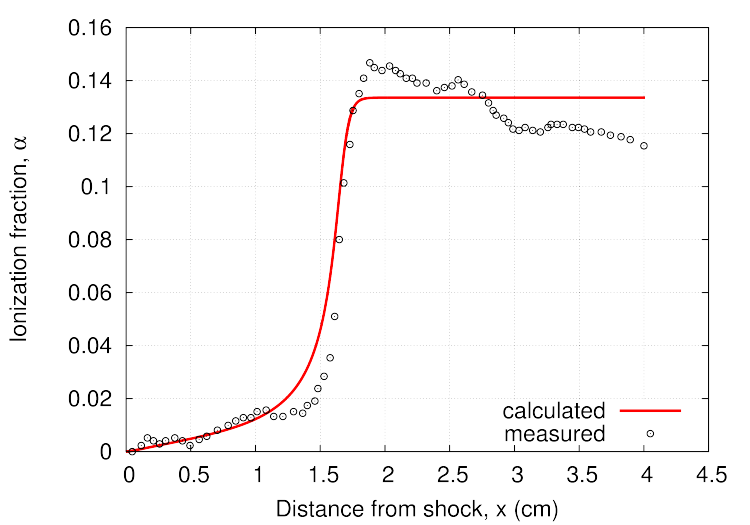Simulation of UTIAS shock tube experiment with Argon¶
Description¶
This example uses Poshax3 to reproduce the ionisation fraction measurements made by Glass and Liu (http://dx.doi.org/10.1017/S002211207800004X) in the UTIAS shock tube with an Argon test gas. The comparison is for the Ms=16.5 case.
This example is found in the code collection at:
$CFCFD/examples/poshax3/Argon/Glass-Liu/M16.5
where there are cases both with and without radiation coupling:
$CFCFD/examples/poshax3/Argon/Glass-Liu/M16.5/with_radiation
$CFCFD/examples/poshax3/Argon/Glass-Liu/M16.5/without_radiation
The files list below is the case with radiation coupling.
Files¶
User-built files:
- argon.cfg
- Input file for Poshax3.
- argon-3sp-2T.inp
- Input file for describing the gas model.
- Hoffert67-Ar-2T.lua
- Input file for the chemical reaction model.
- Ar-TE.lua
- Input file for the energy exchange model.
- argon-radiators-NIST-TB.py
- Input file for describing the radiation model.
- run.sh
- A script to execute the example and plot results.
Gas model input file:
- argon-3sp-2T.lua
- Gas model input file for direct use by Poshax3. This
file is created using the
gasfileprogram.
Radiation model input file:
- rad-model.lua
- Radiation model input file for direct use by Poshax3. This
file is created using the
radmodel.pyprogram.
Output file:
- output.data
- Output file from Poshax3 calculation. This contains flow properties as a function of distance downstream of the shock. This file is only available after running the calculation.
Data files:
- glass_liu_ne_M_16.5.txt
- Ionisation fraction from Figure 7 of Glass and Liu (1978).
Results files:
- profiles.gplot
- A Gnuplot input file for plotting of results.
- ionization_fraction_profile.*
- Plot of the ionisation fraction (electron mole fraction) profile.
- temperature_profiles.*
- Plot of temperature profiles.
Running the simulation¶
The steps to running and plotting results are contained in the script: run.sh.
This can be executed at the command line, from this working directory as:
> ./run.sh
Results¶
This example tests the ability of Poshax3 to correctly solve the post-shock relaxation problem with both thermochemical nonequilibrium and radiation coupling. The output from the calculation are the flow properties against distance behind the shock. The temperature profile for the calculation with radiation coupling is shown below. The heavy particle translation temperature (black) is much larger than the electron temperature immediately behind the shock, as is assumed the translational excitation of free electrons is much slower than that for heavy particles. The two temperature equilibriate approximately 1.75cm behind the shock, and subsequently drop gradually with distance due to radiation cooling.
Comparisons of the ionisation fraction profiles with the results obtained by Glass and Liu in the UTIAS shock tube via two-wavelength interferometry are presented below. The observed relaxation length of 1.8cm is only slightly larger than that predicted by the calculations, however the peak ionisation fraction is slightly underestimated. This is possibly due to deviations of the fill pressure and shock speed from the nominal values in the experiment. A clear difference between the calculations with and without radiation coupling is the slope of the ionisation fraction after the thermochemical equilibration point. Radiation coupling is seen to result in a constant drop in the ionisation fraction, while without radiation coupling the ionisation fraction maintains a steady equilibrium value. The similarity of the observed and calculated slope in this region indicates the radiation model is accurately predicting the rate of cooling. In these calculations radiation at wavelengths less than 200nm was considered to be optically thick, and that at higher wavelengths optically thin. This is a reasonable assumption as VUV radiation is strongly self absorbed.


